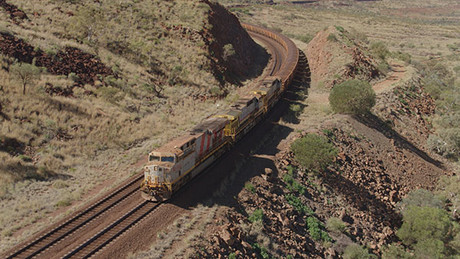Rio Tinto achieves first delivery of iron ore by autonomous train

Rio Tinto has achieved the first delivery of iron ore by an autonomous train in the Pilbara, Western Australia.
The autonomous train, consisting of three locomotives and carrying around 28,000 tonnes of iron ore, travelled over 280 km from Rio Tinto’s mining operations in Tom Price to the port of Cape Lambert on 10 July. It was monitored remotely by operators from Rio Tinto’s Operations Centre in Perth more than 1500 kilometres away.
The inaugural journey is a significant milestone for Rio Tinto’s AutoHaul program and follows regulatory approval in May. AutoHaul is on schedule to complete by the end of the year, unlocking significant safety and productivity gains for the business, as well as optimising the company’s iron ore system by providing more flexibility and reducing bottlenecks.
“The safe first delivery of iron ore by an autonomous train is a key milestone for AutoHaul,” said Ian Vella, Managing Director Rail, Port & Core Services at Rio Tinto. “The program will deliver the world’s first fully autonomous, long-distance, heavy-haul rail network, operating the world’s largest and longest robots.
“This program symbolises both the pioneering spirit and innovative talents of many people across Rio Tinto and shows our absolute commitment to improving safety and productivity, as well as enabling greater flexibility across our operations.
“We will continue to ensure our autonomous trains operate safely under the wide range of conditions we experience in the Pilbara, where we record more than eight million kilometres of train travel each year.
“We are working closely with drivers during this transition period as we prepare our employees for new ways of working as a result of automation.”
The $940 million AutoHaul program, once commissioned, will make the network the world’s first heavy-haul, long-distance autonomous rail operation. Rio Tinto operates about 200 locomotives on more than 1700 km of track in the Pilbara, transporting ore from 16 mines to four port terminals.
The average return distance of these trains is about 800 km with the average journey cycle, including loading and dumping, taking about 40 hours. Locomotives carrying AutoHaul software are fitted with onboard cameras allowing for constant monitoring from the operations centre. All public rail crossings on the network are fitted with CCTV cameras and have been upgraded to the highest safety standards.
DroneShield nabs another European military contract
DroneShield has recently announced it has received a new contract for AU$49.6 million for...
Daikin Australia opens new Sydney factory
Daikin Australia has opened a new factory in Chipping Norton that aims to accelerate the...
AR3 to be first to process rare earths at ANSTO's new pilot facility
Australian Rare Earths has announced that it will be the first industry partner to access...











